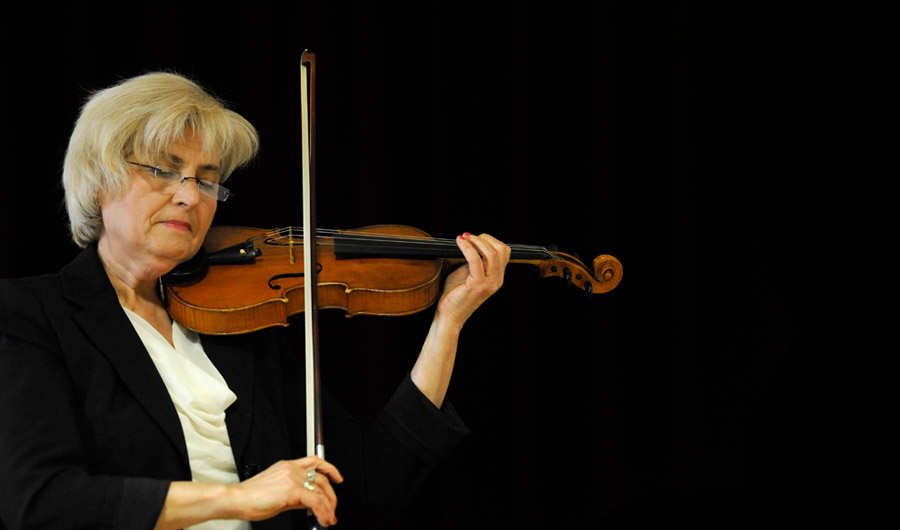Take a Sad Song and Make it Better

Violinist Alexandra Panchina performs during a Holocaust Day of Remembrance event.
U.S. Air Force photo/Senior Airman Aaron-Forrest Wainwright
(Inside Science) -- Very few things can touch human emotions as well as music.
Research has shown how electric connections light up in the brain when music is played, whether it is happy music or sad, and composers can manipulate the reaction.
Most of the time, composers will turn to a solo instrument when they want to evoke sadness, usually an instrument whose tone comes closest to the human voice, according to new research at Ohio State University in Columbus. It gives a feeling of vulnerability, isolation and loneliness.
The research was published in June in the Journal of Music Perception.
It applies to both classical and popular music, said Niels Christian Hansen, a postdoctoral researcher in both cognitive sciences and musicology at Ohio State. The use of solo instruments for effect is easiest to track for the purposes of the study in classical music because the composers can employ any of 30 or so instruments. Most popular musicians use just the guitar.
Hansen has favorite examples. One is a performance by a Dutch orchestra of John William’s heartbreaking music for the film “Schindler’s List.” The passage features a solo violin by Simone Lamsma, supported by an English horn, essentially a large oboe with a lower tone, played by Davida Scheffers. At the end, Lamsma has tears on her cheeks and Scheffers completely falls apart, evoked both by the music and by her return to an orchestra after an illness.
Hansen points to popular music to show it works there as well, mostly in the form of guitar solos such as Eric Clapton’s “Tears in Heaven,” Led Zeppelin’s “Since I’ve Been Loving You,” and the Beatles’ “While My Guitar Gently Weeps.”
The researchers focused on 11 instruments in 330 randomly selected excerpts from classical and popular music and decided if they included solos. Passages that were characterized as sad were twice as likely to include a solo performance, they found.
“You could also do solos to convey … individualism or just to create … contrast in texture and so on. And so, there are all kinds of different reasons why you use instrumentation and our study just explores one of those options,” Hansen said.
“The instruments closest to the human voice are the most effective,” said David Ludwig, chair of composition studies at the Curtis Institute of Music in Philadelphia. A good example is the oboe prelude to Stephen Sondheim’s “Send in the Clowns.” The oboe sets the mood for the words that follow.
Ludwig, who comes from an illustrious music family and has composed for film and concert hall, said he doesn’t think composers (including him) look at a blank score and say to themselves, “I need a solo instrument, I want the audience sad.”
“It’s a point of view I haven’t taken before,” he said. It just happens.
In general, sad music reflects the way people speak when they are sad, Hansen said. “Typically, you speak slower, and you speak more softly.” Music also works that way, he said.
“We become lethargic and retrospective,” said Tuomas Eerola, professor of music cognition at Durham University in England.
Scientists know that there are physiological changes that occur when people listen to sad music, including an increase in dopamine production, Eerola said. Relaxing music does the same.
External factors can play a role, too. It is not just the solo instrument.
Using a minor key can change a happy passage into an unhappy one or the reverse. In his first symphony the German composer Gustav Mahler takes the French children’s song “Frere Jacques,” throws it into a minor key, and orchestrates it like a klezmer funeral march.
There's something about the configuration of the minor keys, said Ludwig.
"The scale is organized so that I think it pulls at our heartstrings a little more than major keys.”
Changing context also changes the mood.
Mahler’s most famous piece is the Adagietto in his fifth symphony, a lovely 10-minute love song to his new love, Alma. In 1971, the Italian director Luchino Visconti filmed an adaptation of Thomas Mann’s novel Death in Venice. At the end, a man sits alone on a desolate Lido beach, has a heart attack and dies, while music plays. The score is the same Adagietto, a love song now played as a lamentation. The only instruction the composer gave in the score was langsam -- slowly.
Neither Samuel Barber’s “Adagio for Strings” nor Johann Sebastian Bach’s “Air on the G String” is intrinsically sad and it is doubtful the composers intended them to be, but both often show up a funerals. They are both slow, quiet and retrospective.
Using a solo to evoke sadness is intuitive, Ludwig said. It isn’t taught in composition courses, but the Ohio State study, he said, fascinated him.
“I think it’s hard to quantify,” Ludwig said, “but in as much as they've kind of broken these things down and created metrics around them, I think this would be a really fascinating resource for artists to at least read about composers and to see how scientists might view that.”

